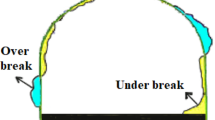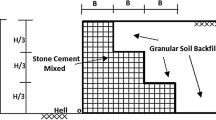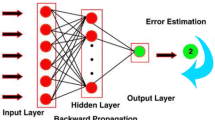Abstract
Overbreak is an undesirable phenomenon in blasting operations. The causing factors of overbreak can be generally divided as blasting and geological parameters. Due to multiplicity of effective parameters and complexity of interactions among these parameters, empirical methods may not be fully appropriated for blasting pattern design. In this research, artificial neural network (ANN) as a powerful tool for solving such complicated problems is developed to predict overbreak induced by blasting operations in the Gardaneh Rokh tunnel, Iran. To develop an ANN model, an established database comprising of 255 datasets has been utilized. A three-layer ANN was found as an optimum model for prediction of overbreak. The coefficient of determination (R2) and root mean square error (RMSE) values of the selected model were obtained as 0.921, 0.4820, 0.923 and 0.4277 for training and testing, respectively, which demonstrate a high capability of ANN in predicting overbreak. After selecting the best model, the selected model was used for optimization purpose using artificial bee colony (ABC) algorithm as one of the most powerful optimization algorithms. Considering this point that overbreak is one of the main problems in tunneling, reducing its amount causes to have a good tunneling operation. After making several models of optimization and variations in its weights, the optimum amount for the extra drilling was 1.63 m2, which is 47% lower than the lowest value (3.055 m2). It can be concluded that ABC algorithm can be introduced as a new optimizing algorithm to minimize overbreak induced by tunneling.







Similar content being viewed by others
References
Bhandari S (1997) Engineering rock blasting operations. A A Balkema, Amsterdam, p 388
Raina AK, Murthy V, Soni AK (2014) Flyrock in bench blasting: a comprehensive review. Bull Eng Geol Environ 73:1199–1209
Koopialipoor M, Armaghani DJ, Hedayat A et al (2018) Applying various hybrid intelligent systems to evaluate and predict slope stability under static and dynamic conditions. Soft Comput. https://doi.org/10.1007/s00500-018-3253-3
Hasanipanah M, Armaghani DJ, Amnieh HB et al (2018) A risk-based technique to analyze flyrock results through rock engineering system. Geotech Geol Eng 36:2247. https://doi.org/10.1007/s10706-018-0459-1
Asadi A, Moayedi H, Huat BBK et al (2011) Artificial neural networks approach for electrochemical resistivity of highly organic soil. Int J Electrochem Sci 6:1135–1145
Moayedi H, Hayati S (2018) Applicability of a CPT-based neural network solution in predicting load-settlement responses of bored pile. Int J Geomech 18:6018009
Hasanipanah M, Jahed Armaghani D, Khamesi H et al (2016) Several non-linear models in estimating air-overpressure resulting from mine blasting. Eng Comput. https://doi.org/10.1007/s00366-015-0425-y
Hasanipanah M, Monjezi M, Shahnazar A et al (2015) Feasibility of indirect determination of blast induced ground vibration based on support vector machine. Meas J Int Meas Confed. https://doi.org/10.1016/j.measurement.2015.07.019
Hasanipanah M, Shahnazar A, Bakhshandeh Amnieh H, Jahed Armaghani D (2017) Prediction of air-overpressure caused by mine blasting using a new hybrid PSO–SVR model. Eng Comput. https://doi.org/10.1007/s00366-016-0453-2
Amiri M, Amnieh HB, Hasanipanah M, Khanli LM (2016) A new combination of artificial neural network and K-nearest neighbors models to predict blast-induced ground vibration and air-overpressure. Eng Comput 32:631–644
Koopialipoor M, Nikouei SS, Marto A et al (2018) Predicting tunnel boring machine performance through a new model based on the group method of data handling. Bull Eng Geol Environ. https://doi.org/10.1007/s10064-018-1349-8
Armaghani DJ, Mahdiyar A, Hasanipanah M et al (2016) Risk assessment and prediction of flyrock distance by combined multiple regression analysis and Monte Carlo simulation of quarry blasting. Rock Mech Rock Eng 49:1–11. https://doi.org/10.1007/s00603-016-1015-z
Armaghani DJ, Hasanipanah M, Mohamad ET (2016) A combination of the ICA-ANN model to predict air-overpressure resulting from blasting. Eng Comput 32:155–171. https://doi.org/10.1007/s00366-015-0408-z
Hasanipanah M, Noorian-Bidgoli M, Jahed Armaghani D, Khamesi H (2016) Feasibility of PSO-ANN model for predicting surface settlement caused by tunneling. Eng Comput. https://doi.org/10.1007/s00366-016-0447-0
Hasanipanah M, Jahed Armaghani D, Bakhshandeh Amnieh H et al (2016) Application of PSO to develop a powerful equation for prediction of flyrock due to blasting. Neural Comput Appl. https://doi.org/10.1007/s00521-016-2434-1
Khandelwal M, Armaghani DJ (2016) Prediction of drillability of rocks with strength properties using a hybrid GA-ANN technique. Geotech Geol Eng 34:605–620. https://doi.org/10.1007/s10706-015-9970-9
Shams S, Monjezi M, Majd VJ, Armaghani DJ (2015) Application of fuzzy inference system for prediction of rock fragmentation induced by blasting. Arab J Geosci 8:10819–10832
Jahed Armaghani D, Mohd Amin MF, Yagiz S et al (2016) Prediction of the uniaxial compressive strength of sandstone using various modeling techniques. Int J Rock Mech Min Sci. https://doi.org/10.1016/j.ijrmms.2016.03.018
Raina AK, Haldar A, Chakraborty AK et al (2004) Human response to blast-induced vibration and air-overpressure: an Indian scenario. Bull Eng Geol Environ 63:209–214
Hajihassani M, Jahed Armaghani D, Monjezi M et al (2015) Blast-induced air and ground vibration prediction: a particle swarm optimization-based artificial neural network approach. Environ Earth Sci 74:2799–2817. https://doi.org/10.1007/s12665-015-4274-1
Marto A, Hajihassani M, Jahed Armaghani D et al (2014) A novel approach for blast-induced flyrock prediction based on imperialist competitive algorithm and artificial neural network. Sci World J 2014:643715
Jahed Armaghani D, Tonnizam Mohamad E, Hajihassani M et al (2016) Evaluation and prediction of flyrock resulting from blasting operations using empirical and computational methods. Eng Comput. https://doi.org/10.1007/s00366-015-0402-5
Momeni E, Jahed Armaghani D, Hajihassani M, Mohd Amin MF (2015) Prediction of uniaxial compressive strength of rock samples using hybrid particle swarm optimization-based artificial neural networks. Meas J Int Meas Confed. https://doi.org/10.1016/j.measurement.2014.09.075
Ocak I, Seker SE (2013) Calculation of surface settlements caused by EPBM tunneling using artificial neural network, SVM, and Gaussian processes. Environ Earth Sci 70:1263–1276
Gordan B, Jahed Armaghani D, Hajihassani M, Monjezi M (2016) Prediction of seismic slope stability through combination of particle swarm optimization and neural network. Eng Comput https://doi.org/10.1007/s00366-015-0400-7
Mandal SK, Singh MM (2009) Evaluating extent and causes of overbreak in tunnels. Tunn Undergr Sp Technol 24:22–36
Monjezi M, Dehghani H (2008) Evaluation of effect of blasting pattern parameters on back break using neural networks. Int J Rock Mech Min Sci 45:1446–1453
Jang H, Topal E (2013) Optimizing overbreak prediction based on geological parameters comparing multiple regression analysis and artificial neural network. Tunn Undergr Sp Technol 38:161–169
Monjezi M, Ahmadi Z, Varjani AY, Khandelwal M (2013) Backbreak prediction in the Chadormalu iron mine using artificial neural network. Neural Comput Appl 23:1101–1107
Hoek E, Brown ET (1980) Underground excavations in rock. CRC Press, Boca Raton
Ebrahimi E, Monjezi M, Khalesi MR, Armaghani DJ (2016) Prediction and optimization of back-break and rock fragmentation using an artificial neural network and a bee colony algorithm. Bull Eng Geol Environ 75:27–36
Saghatforoush A, Monjezi M, Faradonbeh RS, Armaghani DJ (2016) Combination of neural network and ant colony optimization algorithms for prediction and optimization of flyrock and back-break induced by blasting. Eng Comput 32:255–266
Gates WCB, Ortiz LT, Florez RM (2005) Analysis of rockfall and blasting backbreak problems, US 550, Molas Pass, CO. Alaska Rocks 2005, 40th US Symp. Rock Mech
Esmaeili M, Osanloo M, Rashidinejad F et al (2014) Multiple regression, ANN and ANFIS models for prediction of backbreak in the open pit blasting. Eng Comput 30:549–558
Ibarra JA, Maerz NH, Franklin JA (1996) Overbreak and underbreak in underground openings part 2: causes and implications. Geotech Geol Eng 14:325–340
Roth J (1979) A model for the determination of flyrock range as a function of shot conditions. US Department of Commerce NTIS rep no PB81222358, p 61
Lundborg N (1974) The hazards of flyrock in rock blasting. Swedish Detonic Res Found Reports DS 12
Singh SP, Xavier P (2005) Causes, impact and control of overbreak in underground excavations. Tunn Undergr Sp Technol 20:63–71
Koopialipoor M, Armaghani DJ, Haghighi M, Ghaleini EN (2017) A neuro-genetic predictive model to approximate overbreak induced by drilling and blasting operation in tunnels. Bull Eng Geol Environ. https://doi.org/10.1007/s10064-017-1116-2
McCulloch WS, Pitts W (1943) A logical calculus of the ideas immanent in nervous activity. Bull Math Biophys 5:115–133
Garrett JH (1994) Where and why artificial neural networks are applicable in civil engineering. J Comput Civil Eng 8:129–130
Fausett L, Fausett L (1994) Fundamentals of neural networks: architectures, algorithms, and applications. Prentice-Hall, Upper Saddle River
Engelbrecht AP (2007) Computational intelligence: an introduction. Wiley, Hoboken
Ghaleini EN, Koopialipoor M, Momenzadeh M et al (2018) A combination of artificial bee colony and neural network for approximating the safety factor of retaining walls. Eng Comput. https://doi.org/10.1007/s00366-018-0625-3
Monjezi M, Hasanipanah M, Khandelwal M (2013) Evaluation and prediction of blast-induced ground vibration at Shur River Dam, Iran, by artificial neural network. Neural Comput Appl 22:1637–1643
Jahed Armaghani D, Hasanipanah M, Mahdiyar A et al (2016) Airblast prediction through a hybrid genetic algorithm-ANN model. Neural Comput Appl. https://doi.org/10.1007/s00521-016-2598-8
Haykin S, Network N (2004) A comprehensive foundation. Neural Netw 2:41
Jahed Armaghani D, Hajihassani M, Monjezi M et al (2015) Application of two intelligent systems in predicting environmental impacts of quarry blasting. Arab J Geosci 8:9647–9665. https://doi.org/10.1007/s12517-015-1908-2
Koopialipoor M, Fallah A, Armaghani DJ et al (2018) Three hybrid intelligent models in estimating flyrock distance resulting from blasting. Eng Comput. https://doi.org/10.1007/s00366-018-0596-4
Mojtahedi SFF, Ebtehaj I, Hasanipanah M et al (2018) Proposing a novel hybrid intelligent model for the simulation of particle size distribution resulting from blasting. Eng Comput. https://doi.org/10.1007/s00366-018-0582-x
Hasanipanah M, Bakhshandeh Amnieh H, Khamesi H et al (2018) Prediction of an environmental issue of mine blasting: an imperialistic competitive algorithm-based fuzzy system. Int J Environ Sci Technol. https://doi.org/10.1007/s13762-017-1395-y
Hasanipanah M, Faradonbeh RS, Amnieh HB et al (2016) Forecasting blast-induced ground vibration developing a CART model. Eng Comput 33:1–10
Hasanipanah M, Faradonbeh RS, Armaghani DJ et al (2017) Development of a precise model for prediction of blast-induced flyrock using regression tree technique. Environ Earth Sci 76:27
Taheri K, Hasanipanah M, Golzar SB, Majid MZA (2017) A hybrid artificial bee colony algorithm-artificial neural network for forecasting the blast-produced ground vibration. Eng Comput 33:689–700
Hornik K, Stinchcombe M, White H (1989) Multilayer feedforward networks are universal approximators. Neural Netw 2:359–366
Hecht-Nielsen R (1989) Kolmogorov’s mapping neural network existence theorem. In: Proc Int Jt Conf Neural Networks. pp 11–14
Ripley BD (1993) Statistical aspects of neural networks. Netw Chaos Stat Probab Asp 50:40–123
Paola JD (1994) Neural network classification of multispectral imagery. Master Tezi Univ, Arizona
Wang C (1994) A theory of generalization in learning machines with neural network application. Ph.D. thesis, The University of Pennsylvania, USA
Masters T (1993) Practical neural network recipes in C++. Morgan Kaufmann, Burlington
Kanellopoulos I, Wilkinson GG (1997) Strategies and best practice for neural network image classification. Int J Remote Sens 18:711–725
Kaastra I, Boyd M (1996) Designing a neural network for forecasting financial and economic time series. Neurocomputing 10:215–236
Zorlu K, Gokceoglu C, Ocakoglu F et al (2008) Prediction of uniaxial compressive strength of sandstones using petrography-based models. Eng Geol 96:141–158
Karaboga D (2005) An idea based on honey bee swarm for numerical optimization. Technical report-tr06, Erciyes university, engineering faculty, computer engineering department
Nozohour-leilabady B, Fazelabdolabadi B (2016) On the application of artificial bee colony (ABC) algorithm for optimization of well placements in fractured reservoirs; efficiency comparison with the particle swarm optimization (PSO) methodology. Petroleum 2:79–89
Ahmad A, Razali SFM, Mohamed ZS, El-shafie A (2016) The application of artificial bee colony and gravitational search algorithm in reservoir optimization. Water Resour Manag 30:2497–2516
Zhang C, Ouyang D, Ning J (2010) An artificial bee colony approach for clustering. Expert Syst Appl 37:4761–4767
Rodriguez FJ, García-Martínez C, Blum C, Lozano M (2012) An artificial bee colony algorithm for the unrelated parallel machines scheduling problem. In: International conference on parallel problem solving from nature. Springer, Berlin, pp 143–152
de Oliveira IMS, Schirru R, de Medeiros J (2009) On the performance of an artificial bee colony optimization algorithm applied to the accident diagnosis in a pwr nuclear power plant. 2009 Int. Nucl. Atl. Conf. (INAC 2009)
Karaboga D, Basturk B (2007) A powerful and efficient algorithm for numerical function optimization: artificial bee colony (ABC) algorithm. J Glob Optim 39:459–471
Gordan B, Koopialipoor M, Clementking A et al (2018) Estimating and optimizing safety factors of retaining wall through neural network and bee colony techniques. Eng Comput. https://doi.org/10.1007/s00366-018-0642-2
Acknowledgements
The authors would like to express their sincere appreciation to the anonymous reviewers for their valuable and constructive suggestions.
Author information
Authors and Affiliations
Corresponding author
Additional information
Publisher’s Note
Springer Nature remains neutral with regard to jurisdictional claims in published maps and institutional affiliations.
Rights and permissions
About this article
Cite this article
Koopialipoor, M., Ghaleini, E.N., Haghighi, M. et al. Overbreak prediction and optimization in tunnel using neural network and bee colony techniques. Engineering with Computers 35, 1191–1202 (2019). https://doi.org/10.1007/s00366-018-0658-7
Received:
Accepted:
Published:
Issue Date:
DOI: https://doi.org/10.1007/s00366-018-0658-7




